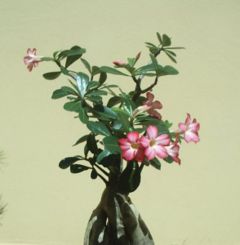Adenium
| Adenium obesum {{{status}}} Fossil range: {{{fossil_range}}}
| ||||||||||||||||||||||||||||||||||||||||||||||||||||||||||||||||||
|---|---|---|---|---|---|---|---|---|---|---|---|---|---|---|---|---|---|---|---|---|---|---|---|---|---|---|---|---|---|---|---|---|---|---|---|---|---|---|---|---|---|---|---|---|---|---|---|---|---|---|---|---|---|---|---|---|---|---|---|---|---|---|---|---|---|---|
 A plant showing the swollen basal caudex | ||||||||||||||||||||||||||||||||||||||||||||||||||||||||||||||||||
| Plant Info | ||||||||||||||||||||||||||||||||||||||||||||||||||||||||||||||||||
| ||||||||||||||||||||||||||||||||||||||||||||||||||||||||||||||||||
| Scientific classification | ||||||||||||||||||||||||||||||||||||||||||||||||||||||||||||||||||
| ||||||||||||||||||||||||||||||||||||||||||||||||||||||||||||||||||
| [[{{{diversity_link}}}|Diversity]] | ||||||||||||||||||||||||||||||||||||||||||||||||||||||||||||||||||
| {{{diversity}}} | ||||||||||||||||||||||||||||||||||||||||||||||||||||||||||||||||||
| Binomial name | ||||||||||||||||||||||||||||||||||||||||||||||||||||||||||||||||||
| Adenium obesum (Forssk.) Roem. & Schult. | ||||||||||||||||||||||||||||||||||||||||||||||||||||||||||||||||||
| Trinomial name | ||||||||||||||||||||||||||||||||||||||||||||||||||||||||||||||||||
| {{{trinomial}}} | ||||||||||||||||||||||||||||||||||||||||||||||||||||||||||||||||||
| Type Species | ||||||||||||||||||||||||||||||||||||||||||||||||||||||||||||||||||
| {{{type_species}}} | ||||||||||||||||||||||||||||||||||||||||||||||||||||||||||||||||||
| {{{subdivision_ranks}}} | ||||||||||||||||||||||||||||||||||||||||||||||||||||||||||||||||||
| [[Image:{{{range_map}}}|{{{range_map_width}}}|]] | ||||||||||||||||||||||||||||||||||||||||||||||||||||||||||||||||||
| Synonyms | ||||||||||||||||||||||||||||||||||||||||||||||||||||||||||||||||||
| {{{synonyms}}} |
Adenium is a genus of flowering plants in the family Apocynaceae, containing a single species, Adenium obesum, also known as Sabi Star, Kudu or Desert-rose. It is native to tropical and subtropical eastern and southern Africa and Arabia.

It is an evergreen succulent shrub, growing to 1-3 m in height, with pachycaul stems and a stout, swollen basal caudex. The leaves are spirally arranged, clustered toward the tips of the shoots, simple entire, leathery in texture, 5-15 cm long and 1-8 cm broad. The flowers are tubular, 2-5 cm long, with the outer portion 4-6 cm diameter with five petals, resembling those of other related genera such as Plumeria and Nerium. The flowers tend to red and pink, often with a whitish blush outward of the throat.
Several regional subspecies occur:
- Adenium obesum subsp. boehmianum. Namibia, Angola.
- Adenium obesum subsp. obesum. Arabia.
- Adenium obesum subsp. oleifolium. South Africa, Botswana.
- Adenium obesum subsp. socotranum. Socotra.
- Adenium obesum subsp. somalense. Eastern Africa.
- Adenium obesum subsp. swazicum. Eastern South Africa.
These subspecies are often considered proper species.
Cultivation and uses
Adenium is a popular houseplant in temperate regions. It requires a sunny location and a minimum indoor temperature in winter of 10 °C. It thrives on a xeric watering regime as required by cacti. Adenium is typically propagated by seed or stem cuttings. However, only those grown from seed would have the swollen caudex that is prized by collectors.
Common Names
Due to its resemblance to plumeria and was introduced to the Philippines from Bangkok, Thailand, the plant was also called as Bangkok kalachuchi in the Philippines.
External links
-
Adenium obesum
